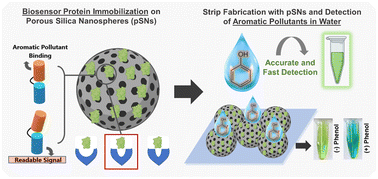Porous silica nanospheres: a nanoplatform towards protein immobilization and cogent design of biosensors for aromatic water pollutant detection†
Abstract
Accurate tracking of aromatic pollutants in the field of environmental biotechnology requires significant attention owing to their hazardous health-related implications. In particular, direct detection of acutely toxic aromatic xenobiotics including phenol, benzene, catechol, etc. in water samples remains a challenge. Here, we methodically study the classical attributes of nano-supports that are paramount to attain a suitable enzyme–nano-support matrix by employing MopR, a phenol biosensor as a model system. A series of porous silica nanospheres (pSNs) of different physicochemical properties were explored as a potential nanoplatform for MopR immobilization. The sensor constructed with an average pore size of about 9 nm and total pore volume of 1.12 cc g−1 exhibit the highest sensitivity to detect phenol, down to 0.1 μM (10 ppb). The designed sensor proved to be robust, selective, and sensitive in real environmental samples exhibiting high accuracy within detection limits. Furthermore, to understand the mechanism of immobilization and to refine the protein–matrix interactions, Ni-NTA functionalized pSNs were synthesized. Results show that the enzyme requires conformational flexibility and a combination of chemical tethering and apt pore shape, and the volume of the nano-support is fundamental for the activity of the biosensor. The present in-depth study opens a new dimension in mesoporous nanomaterials and guides the development of smart biosensors for environmental monitoring of xenobiotics.

- This article is part of the themed collection: Nanomaterial applications in water


 Please wait while we load your content...
Please wait while we load your content...